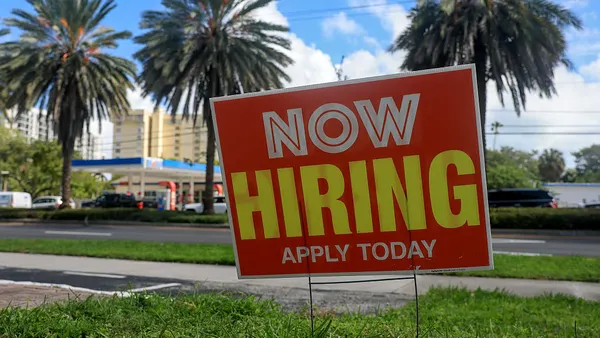Businesses often see CIOs as order-takers, tasked with keeping the lights on. CTOs, on the other hand, are dedicated to the customer experience and innovation.
Spearheading technology, CIOs and CTOs are encouraged to collaborate, sometimes blurring the lines between roles. In some cases, the roles are so intertwined, companies will consolidate the executive position.
"The CTO and CIO are two distinct yet complementary roles [and] we see clear ways in which they can form a synergistic partnership," Samantha Searle, principal research analyst at Gartner, told CIO Dive.
At exercise equipment and software subscription company Peloton, cofounder Yony Feng operates as CIO and CTO. He's been CTO since 2012 and added the CIO title in April.
Peloton, borne from sport and technology, has an obligation to customers to maintain digital savviness. Feng has to weave technology into Peloton's product experience and "into every touch point we have with our members," he told CIO Dive in an email. "By merging CTO and CIO into a single role, Peloton is making a statement about how we see technology and where we want to bring our innovative thinking."
Feng wears the CIO and CTO hats simultaneously. Other companies opted for one tech chief; even if it required a title change.
"By merging CTO and CIO into a single role, Peloton is making a statement about how we see technology and where we want to bring our innovative thinking."

Yony Feng
CIO/CTO of Peloton
In September, Kohl's tapped former Dick's Sporting Goods CTO Paul Gaffney to become CTO but with traditional CIO responsibilities. In February, cranberry co-op Ocean Spray transitioned CIO Jamie Head's title to CTO and chief digital officer, about seven months into his tenure. The same thing happened to Christopher Caldwell, who transitioned from CIO to CTO at fried chicken chain KFC earlier this year.
Shifting from CIO to CTO "was a somewhat recent change [as we're] more focused on the consumer-facing technology," Caldwell told CIO Dive. "I still have the traditional CIO responsibilities, but my role is the CTO at KFC."
Where CIO meets CTO
Despite recent examples, it's more common for companies to separate the CIO and CTO roles and the individuals sitting in them.
In companies with separate roles, the CIO and CTO report to the CEO, according to Searle. It's also less likely that a CTO would report to a CIO.
More than half of CTOs see their roles clearly differentiated from the CIOs, according to a Gartner survey. At the same time, the CTO "is one of the least understood of all C-level positions."
"You've got the traditional CIO stuff, which is good, but a lot of work to do."

Jamie Head
CTO/CDO of Ocean Spray
"There are definitely things going on in terms of flux" because some organizations may find their existing CIO or CTO is adaptable to new skills, said Searle. If the individual can take on new skills, be digitally business savvy, B2C business literate, and understand the challenges of emerging technologies, then a role consolidation is possible.
When an individual can master all of these factors, then that's "where we tend to see these kind of turnovers," said Searle. While it's more "beneficial to have two individuals that can work in partnership than to have one person" as CIO and CTO, it's a luxury some companies don't have.
Wearing both hats, Head knows how his responsibilities as CIO and CTO are split.
"Tech has its own master hierarchy … you've got all your fancy AI, and analytics and things like that. But you really have to make sure to invest in your people and keep investing in your core operational activity," said Head.
If operations start to suffer because of experimental innovation, the C-suite will lose confidence in IT. Losing too much of the CIO focus, or focus on internal processes, "will come back to bite you," he said.
From CIO to CTO
Historically, the CIO and CTO each had a hand in IT operations.
The CIO oversaw software support whereas the CTO managed data centers. The CTO was a solution for the CIO "spreading themselves too thin," said Searle.
But as more funds are dedicated to the cloud and less to data centers and infrastructure, both executives will have freed up time once dedicated to software and hardware management.
The IT landscape is changing; CTOs are less encumbered by back office operations and will have "the opportunity to become a technology visionary," said Searle.
The CTO's organization is accountable for leveraging and seizing opportunities made possible by emerging technologies. Companies — including Walmart, Northwestern Mutual, GE and Nestlé — have CTOs who lead innovation efforts and IT operations, similar to Head.
When Head took on the CTO and CDO titles, while maintaining his original CIO responsibilities, it was a way for Ocean Spray to break out of the confines of its legacy tech and move to market faster.
The CDO title also helped Ocean Spray breakdown silos among departments. The cranberry co-op "spun up" a digital hub. To help marketing, the hub is responsible for activation on social channels, content and commerce.
By technologically innovating departments outside of IT, Ocean Spray has to continuously "test and learn technology with that group that we wouldn't otherwise test in the core business," said Head. "That is a really useful testing ground for not just products in the marketplace, but beyond the products and what technology can help drive the business forward."
Consumer-facing changes
As CIOs take a larger role in shaping overall business strategy, their focus is shifting away from delivering customer solutions.
"I see my customers as not only the end consumer, but also like our franchisees and our operators."

Chris Caldwell
CTO of KFC
About 44% of CTOs have a focus on customer solutions while CIOs' attention is on internal systems, according to Gartner. Head and Caldwell fall in with the 37% of CTOs who say their responsibilities are more or less evenly split between customer-facing services and internal operations.
"You've got the traditional CIO stuff, which is good, but a lot of work to do," said Head. As a consumer goods organization, Ocean Spray "needs to focus a lot around the consumer and getting close to the consumer … that requires a lot of technology horsepower."
Those who manage CTOs and CIOs see the former as a role dedicated to customer solutions, according to Gartner. Their goal is customer satisfaction and retention.
"I see my customers as not only the end consumer, but also like our franchisees and our operators," said Caldwell. "It's not just about the technology. And we've got a lot of amazing technologists here."
CTOs now have a primary focus on external, customer-facing operations, including customers and partners like Caldwell's.
A company's decision to change an individual's title from CIO to CTO is indicative of larger goals.
"Perhaps it is saying that they are stepping away from what we're seeing as a traditional CIO role," said Searle, it's saying "we are a company that is taking a step on this journey to become more of a digital business."




















